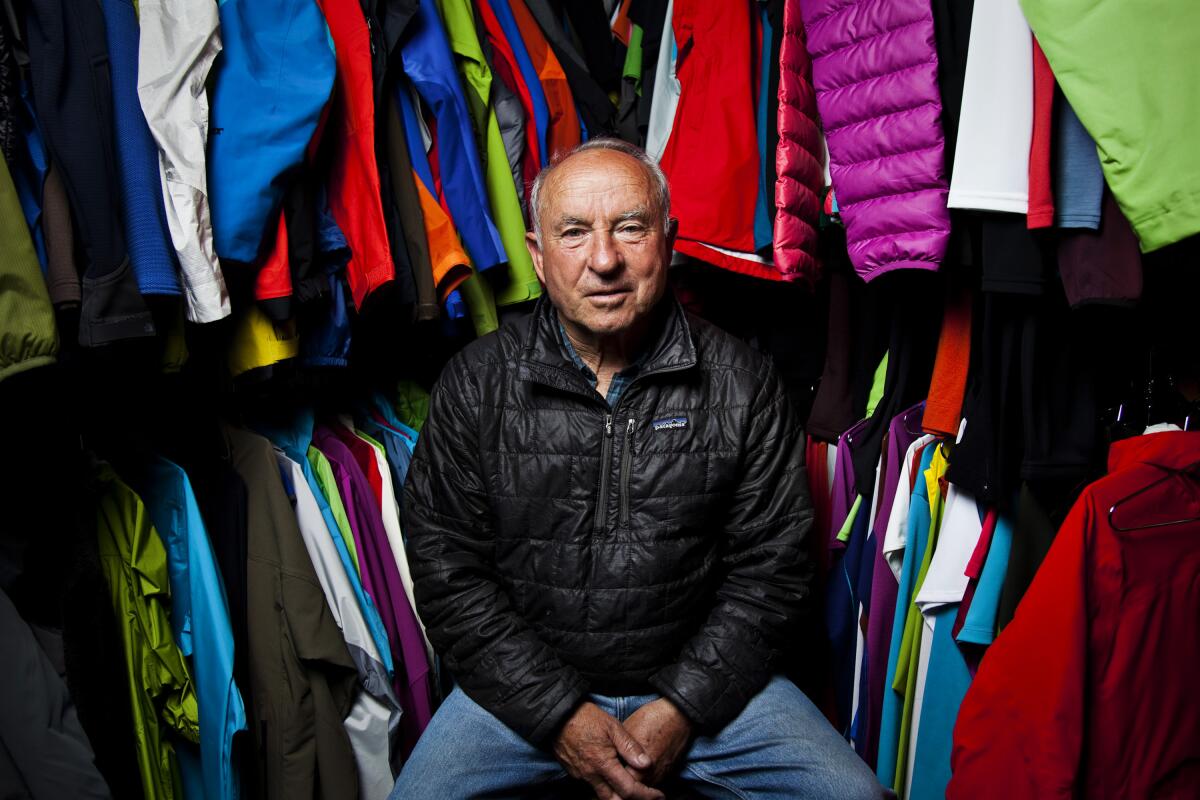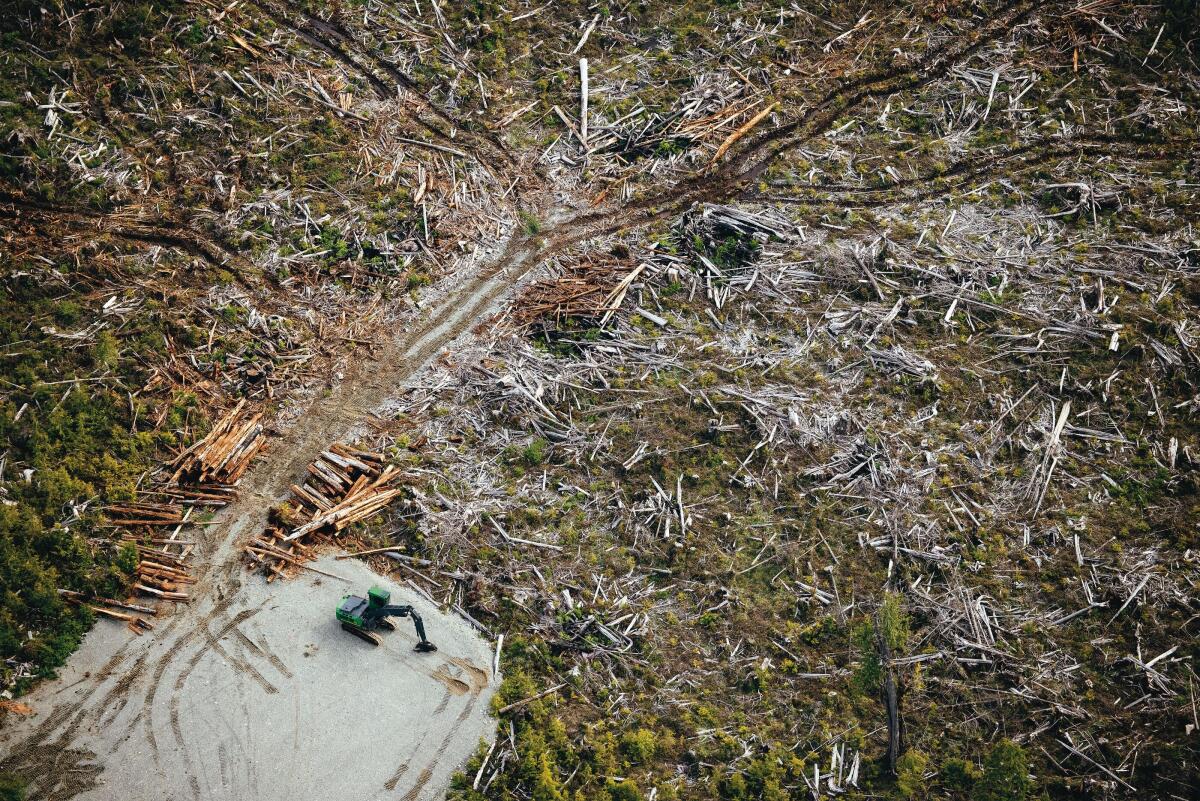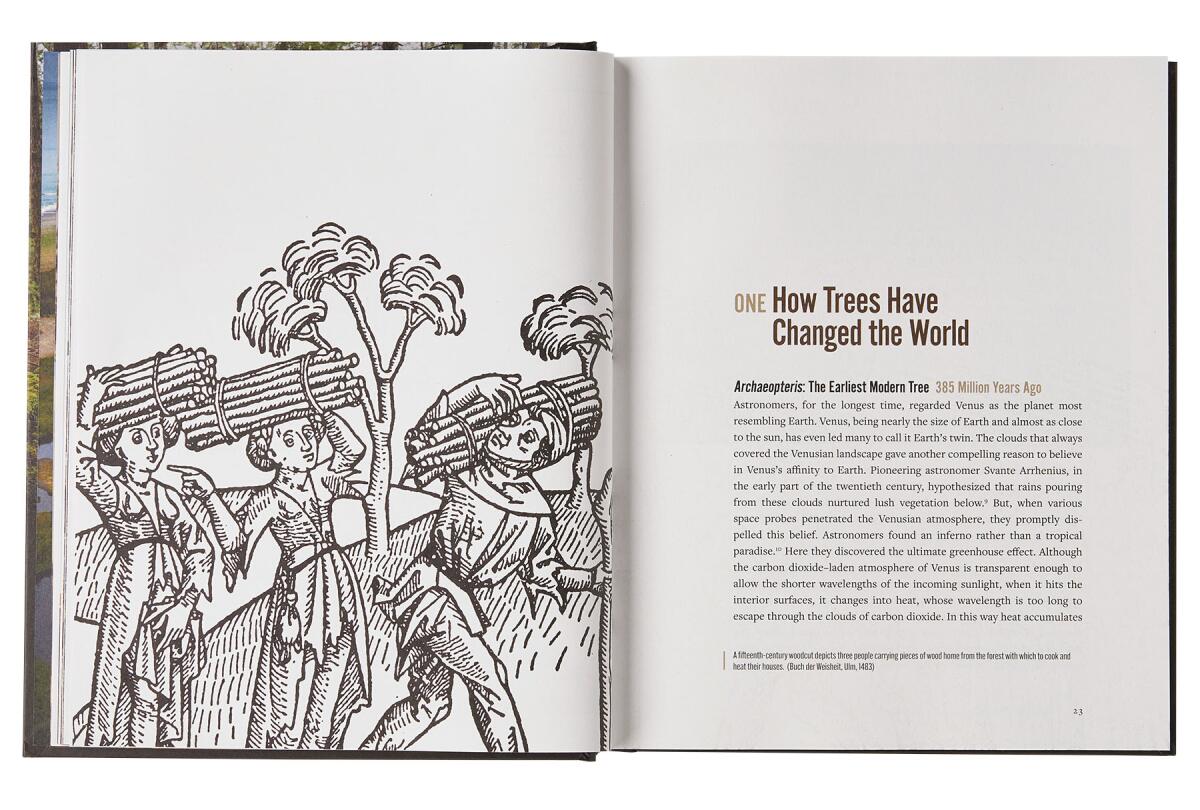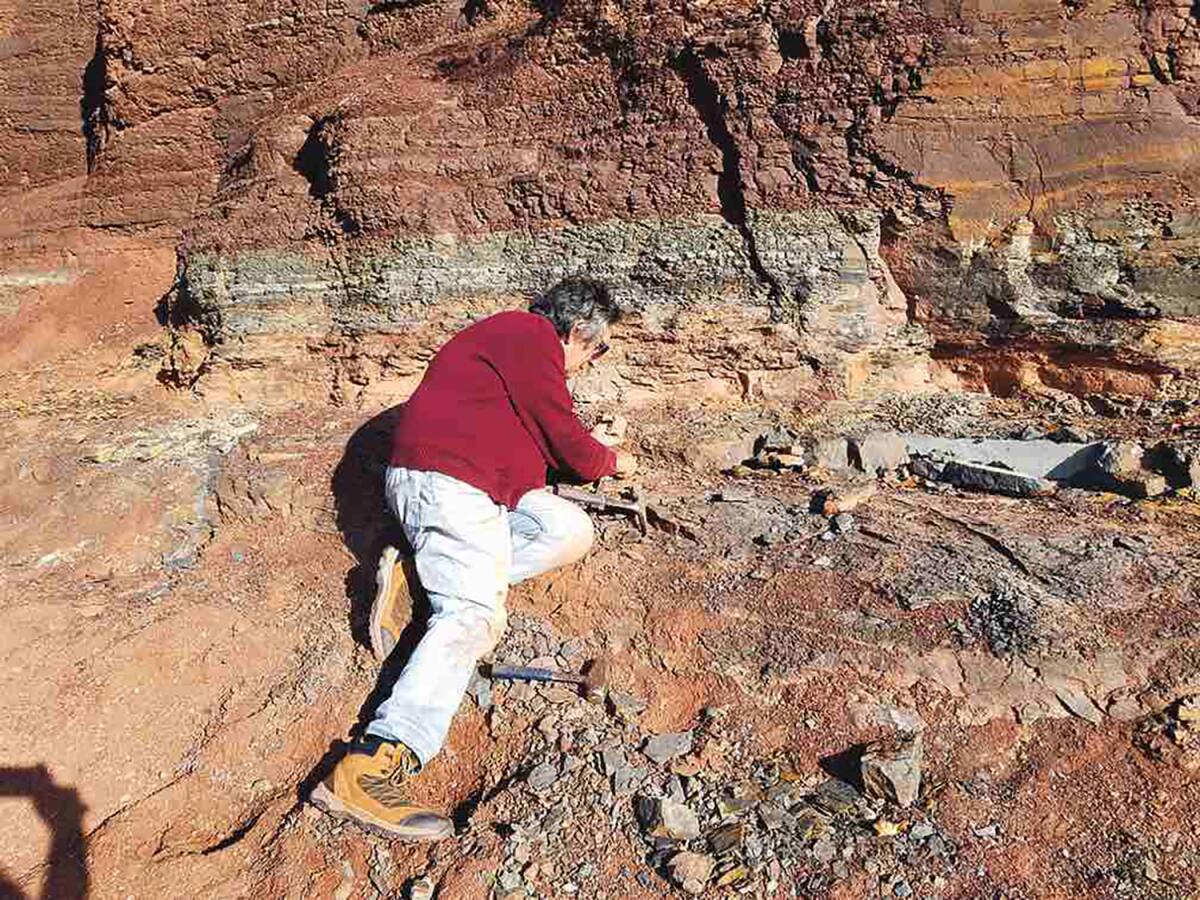Sign up for our Book Club newsletter
Get the latest news, events and more from the Los Angeles Times Book Club, and help us get L.A. reading and talking.
You may occasionally receive promotional content from the Los Angeles Times.

On the Shelf
A Forest Journey: The Role of Trees in the Fate of Civilization (Revised)
By John Perlin
Patagonia: 520 pages, $38
If you buy books linked on our site, The Times may earn a commission from Bookshop.org, whose fees support independent bookstores.
Beginning 385 million years ago, trees made the proliferation of life on Earth possible. With the emergence of Archaeoptreis, one of the earliest modern trees, our carbon dioxide-blanketed planet was transformed into a hospitable environment for other life forms, including vertebrates and ultimately humans, to develop and flourish. It goes almost without saying that we are not repaying the favor.
The extensive history of forests, from the distant past to our current climate chaos, and the little recognized role wood products served in the development of human civilizations is the life’s work of author John Perlin. In 1989, the Los Angeles native published “A Forest Journey: From Mesopotamia to North America.” Now, 34 years later, with the help of two influential supporters, the book is embarking on a new journey.
An updated third edition of “A Forest Journey” is out next week from a new publisher, Patagonia. Yes, that Patagonia. The company that began manufacturing pitons in 1973 and became a global outdoor apparel giant began its own publishing program in 2007.
Yvon Chouinard has always said Patagonia’s mission was to protect nature. In donating his shares to a trust and a nonprofit, he ensures his life’s work will continue.
Perlin, now 78, is also the author of three books on solar energy and a visiting scholar in the department of physics at UC Santa Barbara. Until 2018, he was unaware that the co-founders of Patagonia, Malinda and Yvon Chouinard, were devoted fans who had spent years recommending the book to anyone who would listen. That year, he received an email from publisher Karla Olson, sharing that the Chouinards had first read “A Forest Journey” 25 years ago and had never forgotten the book’s message.
Patagonia’s book program began after Yvon Chouinard published his business memoir, “Let My People Go Surfing,” in 2005. The first book his company published was “Yosemite in the Sixties” by Glen Denny, a collection of black-and-white rock climbing photography in the Yosemite Valley. Patagonia quickly ramped up to between five and eight titles per year, including adventure stories, memoirs by athletes and explorers, and books by pioneering environmental scientists.

Last year, the Chouinards transferred their family’s ownership of the private company to a specially designed trust and nonprofit organization devoted to environmental sustainability, although they remain heavily involved across Patagonia — including its books division.
Perlin’s book is a natural fit for the imprint, and it couldn’t be more timely, given its emphasis on mitigating climate change by renewing our symbiotic relationship with the trees that have sustained us. “A Forest Journey” is an approachable, accessible monograph with an impressively broad scope. From construction to fuel to weaponry, Perlin shows that wood may be humanity’s most essential material.
As we proceed to demolish the last great forests on Earth in the tropics of both Africa and America, it is easy to believe this catastrophic event is a novelty.
When “A Forest Journey” was first published, the intertwined history of people and trees was a little-explored topic. The book was recognized as a Harvard Classic in Science and World History and was listed as one of the university’s One Hundred Great Books. David Graeber, an anthropologist who would go on to write bestselling historical narratives, compared it to “some Greek epic poem spanning 4,000 years of civilization” in a review for The Times.
By 2017, however, it was difficult to find a copy; the “inevitably tragic” book, as Graeber had put it, faded in popularity among readers likely more accustomed to zippier histories of resources like cod or salt. But for the Chouinards, “A Forest Journey’’ remains a foundational conservation story, one that helps contextualize the current climate crisis. And so they asked to republish it.
“Oh, you might say it was the dream of my life,” Perlin said by video from his home in Santa Barbara, on how it felt to receive their invitation.

Not only was Patagonia offering to revive the relatively obscure title but it would also provide an opportunity for the insatiably curious scholar to supplement his edition with new research.
“I kept piling up ideas, and also in the last 30 years of scholarship, I had all this wonderful material, and no one wanted it,” he said. “And then suddenly, my angels come flying up from Ventura.”
The new, expanded edition, now subtitled “The Role of Trees in the Fate of Civilization,” was originally scheduled to publish in 2020 but was delayed when Patagonia put its books on pause during the COVID-19 pandemic. The silver lining: It gave Perlin more time to add new material, including a section on forests and human health. Olson described Perlin as “incredibly erudite,” and this is evident on the page.
Suzanne Simard’s groundbreaking research inspired Richard Powers’ ‘The Overstory.’ Now she’s published her own memoir, ‘Finding the Mother Tree.’
New research has demonstrated that deforestation increases the spread of diseases like Lyme in the northeastern United States, and a 2018 paper in the journal Frontiers in Microbiology theorized that bats and coronaviruses were linked to human interference with natural habitats. It was a prescient finding that Perlin felt compelled to add to “A Forest Journey,” timely evidence of the critical relationship between trees and human health.
Aligning with its mission for sustainability and environmental protection, Patagonia uses 100% post-consumer waste recycled paper. “A Forest Journey” contained extensive end notes, tallying 80 pages; in an effort to reduce paper use, these were replaced by online resources to house footnotes and interactive maps, along with a forthcoming teachers guide. Another hallmark of the books is its striking use of images alongside the text. The book is studded with commanding color photography and graphics, creating an immersive landscape that leavens the dense text.

“We’re a little, tiny piece of the publishing industry, but we’re trying to challenge [publishers] to rethink the way they do some things, including printing on virgin paper,” Olson said.
Perlin wants people to understand that trees are the reason for the development of culture, including books. “Wood, in fact, is the unsung hero of the technological revolution that has brought us from stone-and-bone culture to our present age,” he writes.
What Perlin jokingly calls his “wood work” was inspired by a story from 5,000 years ago in southern Mesopotamia, recorded on a clay tablet as “The Epic of Gilgamesh.”
“I will fell the great forest,” cried the legendary Sumerian hero. Perlin believes this has become the mantra of society ever since Gilgamesh and his men plundered the great primeval woodland. From the Fertile Crescent to ancient Chinese and Indian empires to the more recent arrival of European colonists to North America, Perlin reveals a repeated pattern of humans failing to see the forests for the trees.
Obi Kaufmann’s ‘The Forests of California’ is the latest in a series that suggests we need to understand nature in order to save it.
“Sadly the present assault on our forests is part of the same cycle begun thousands of years ago,” he writes. “Every Old World starts out as virgin land attractive to human settlement. Subsequent exploitation by humans wears out the land, forcing them to move on to their next New World. This quest for new frontiers, which many have thought peculiar to the American experience, is repeated again and again.”
Perlin’s 30,000-foot purview is what interests Olson. “It is so broad both over time, and culturally, and it is a really interesting perspective that I think is going to surprise people,” she said.

Archaeoptreis made much of life possible, and unless the current cycle of land degradation is broken, the absence of trees will lead to the absence of most everything else. Three progressively warming decades since “The Forest Journey” was first published, the new edition highlights the ways in which we can protect old-growth forests, which are natural vessels for carbon sequestration. Cities like New York and Seattle now recognize the value of sustaining trees for maintaining the integrity of freshwater supply, investing in conservation easements to protect forests and watersheds — a new ray of hope at the end of Perlin’s story.
“I tried to use 1,000 voices of the past,” Perlin said of his storytelling method. Of those many voices he collected in writing “A Forest Journey,” the author wonders whether we will continue to mimic Gilgamesh’s battle cry, which ultimately cursed him, or if we might exercise our voices to ensure our own survival.
Doherty is a writer, opinion columnist and book reviewer and lives in Kalispell, Montana.
Sign up for our Book Club newsletter
Get the latest news, events and more from the Los Angeles Times Book Club, and help us get L.A. reading and talking.
You may occasionally receive promotional content from the Los Angeles Times.